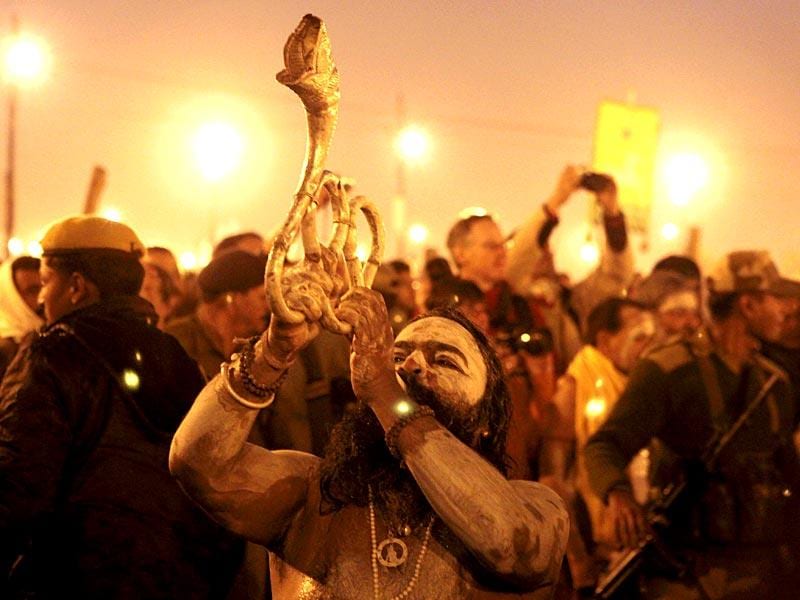This is how a group of local techies are hacking Nashik’s Kumbh Mela
On July 14, as 30 million pilgrims from across the country descended on the sleepy little town of Nashik in western Maharashtra, an otherwise desolate compound bustled with a hundred college students. They came from across the country — from Chennai, Pune, New Delhi, Mumbai, and more — and they were all discussing the same thins: wearable devices, hackathons and their favourite startups.


On July 14, as 30 million pilgrims from across the country descended on the sleepy little town of Nashik in western Maharashtra, an otherwise desolate compound in the heart of the city bustled with a hundred college students. They came from across the country — from Chennai, Pune, New Delhi, Mumbai, and more — and they were all discussing the same things: wearable devices, hackathons and their favourite startups (Zomato seemed to be an all-round hit).
The students had made the trip to Nashik for the Kumbhathon, an annual hackathon started by local tech enthusiasts and a team from the MIT in January 2014, to build technology solutions to not only address public safety, health and sanitation challenges during the Kumbh Mela but also develop them further and turn Nashik into a 'smart city' in the years to come.
"Nashik is a great sandbox to experiment and build customised tech solutions for non-metro cities," said Professor Ramesh Raskar, a Nashik local who is Associate Professor of Media Arts and Sciences at MIT's Media Lab in Boston. When Raskar and his team visited Nashik in 2013 to meet local professors and technologists, they realised that the upcoming Kumbh Mela might be a great place to build and test city oriented tech solutions.
"We're doing this for Nashik," says Sachin Shinde, CEO and co-founder of the Kumbha Foundation, which organises the event each year. Last year, Shinde took a sabbatical from his job as software engineer at TCS to put the city he has grown up in on the startup map of India. His efforts are paying off. In just over a year, the Kumbha Foundation has seen a constant influx of new students and mentors from Microsoft Research India, Google India, Tata Trust, Xerox Research Center, various IITs and the government.
Bhavana, a student of K.K. Wagh College of Engineering in Nashik who has been a part of previous Kumbhathons, explained, "Initially we pitched ideas on-site and developed them in a week. But, you can barely even prototype in a week." In the latest iteration, the Kumbhathon team developed a list of twelve ideas such as 'Epidemic Tracker', a mobile application that displays a disease outbreak in real time, 'Shops Online', a project to create digital presence for small and big shops in Nashik, 'GoFoodGo', a project to list and distribute leftover food from restaurants, and 'Local Community Radio' ready for participants to work on. Besides, participants could also pitch their own ideas while registering for the event. The Nashik city mobile app developed in Kumbhathon I in 2014, has now been approved as the official city app and will continue to add more city-centric features.
A number of hi-tech initiatives have emerged as a result of the hackathons such as the 'Crowd Management' app to combat overcrowding in the Kumbh Mela This location-based app identifies and displays high-density areas to help with crowd dispersion.
Dr Pratik Shah, a fellow at MIT's Broad Institute, who is working closely with city clinicians on public health projects explains: "As the Kumbathon has progressed since 2014, more institutions, students and government officials, have joined various projects to increase the impact. Needless to say, these solutions will be useful even after the mela."
Oof the older projects from Kumbhathon I that will be tested at the Mela is pop-up housing, developed by Bangalore-based engineer Sampath Reddy and Freeman Murray, Founder of Jaaga, Bangalore, along with students they met in Nashik. Reddy explains: "There are 28,000 hotel rooms in Nashik and we're expecting 30 million people. The existing built environment can't cater to this huge influx. Temporary housing like this can serve disasters, events and slum rehabilitation projects." After multiple pitches to the Mela planning authorities, Reddy was able to construct India's first multi-level modular structure at Sadhugram I, a central point in the Kumbh Mela, built for ₹ 3 lakh that can house up to 30 people for over 15 years.
Given the issues with telecom infrastructure in tier II cities, Raskar suggests we adopt a "bottom-up" approach by making smart citizens first — people who widely use tech solutions — instead of fixating on infrastructural development. For him, if citizens adopt a service and make it popular, the incentive for government to embrace it is high. However, in order to even implement mobile based solutions built at the Kumbhathon, one would require stable Internet connectivity, access to smartphones and mobile literacy in order for them to be useful to the public at large. While solutions like cashless payments work well in metros, they may not work if local vendors don't have payment gateways set up. And collecting and storing big data on public health always poses privacy risks.
What is heartening about such an initiative is that Deependra Singh Khushwah the Collector of Nashik, and Municipal Commissioner Praveen Gedam have been closely engaging with the hackathon teams to facilitate data collection and permissions for students.
While a hackathon (or build-a-thon as Raskar calls it) may not instantly convert Nashik into a smart city, their interactions, successes and failures make it obvious that implementing smart solutions in cities beyond metros will require a different understanding of the local ecology, urban planning and viable technology solutions that can operate within the limitations of the current infrastructure. It will expand the current imagination of 'Internet of Things' (IoT) to include the 'Internet of Developing Things'.
However, what such events can do is prepare citizen communities to receive new technologies. They can also be instrumental in providing students from cities like Nashik a gateway to join the techno-innovation wave sweeping the larger cities of India.
Catch all the Latest Tech News, Mobile News, Laptop News, Gaming news, Wearables News , How To News, also keep up with us on Whatsapp channel,Twitter, Facebook, Google News, and Instagram. For our latest videos, subscribe to our YouTube channel.

























